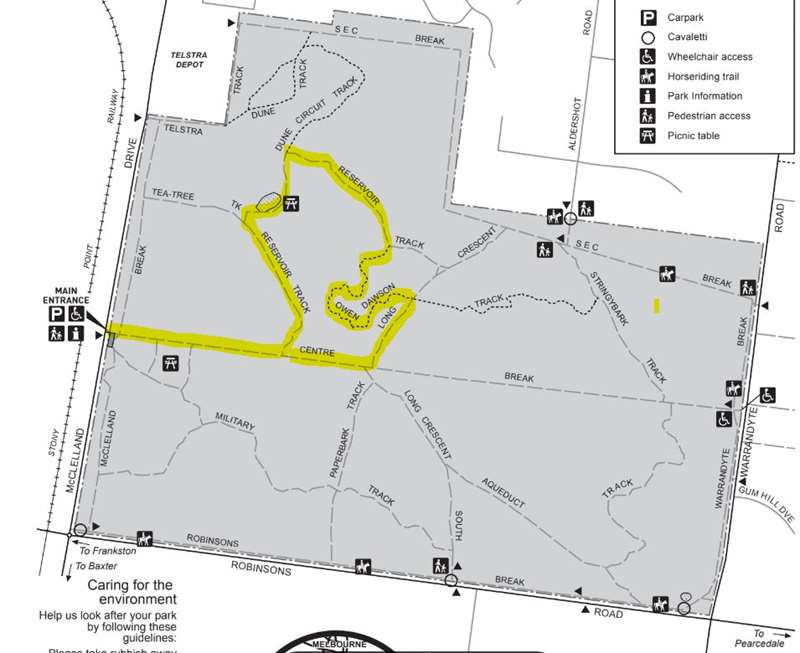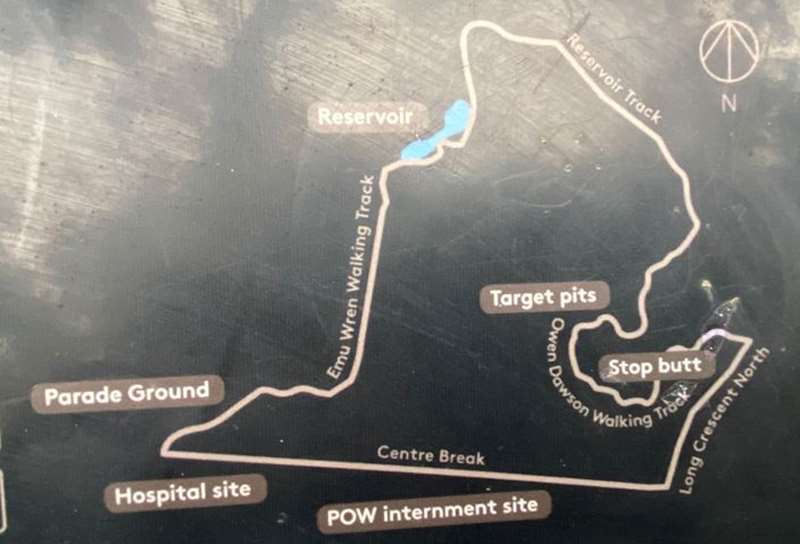Langwarrin Flora and Fauna Reserve (Langwarrin)

.jpg)
The 214-hectare Langwarrin Flora and Fauna Reserve, a former military reserve, is an island of relatively undisturbed natural bushland surrounded by the suburbs of Frankston and Langwarrin.
The park has an important place in military history with almost a 100 year history of military use spanning from 1886 to 1979.
The track network transects a range of vegetation communities and provides access to historical sites.
It's an important habitat for native flora and fauna, ideal for quiet recreational activities such as walking, nature study and photography. You may be lucky to spot koalas, brown bandicoots, swamp wallabies and even the rare New Holland mouse.
There is a network of tracks which allows visitors to walk to most features of the reserve. In keeping with the primary objective of protecting the reserve's conservation values, public facilities such as toilets, barbecues and picnic tables are not provided.
Horse riding is permitted however only on the trail provided beside Robinsons and Warrandyte roads.
History
This reserve and surrounding lands were originally occupied by the Boonerwrung tribe who travelled across the peninsula in search of seasonally available foods. Evidence of a lithic (stone) scatter can be seen within the reserve and serve as the material remains of past Aboriginal occupation. The Reserve, first established as the Langwarrin Military reserve in 1886, was used for various activities by the Victorian colonial defence forces. During World War 1, German prisoners of war were detained at the reserve and a hospital was set up for the treatment of soldiers returning from France and Egypt.
Today all the military buildings are gone, however evidence of the reserves past use remains in the form of the stone capped reservoir, rifle butts and the fountain located on the old hospital site.
Location and Access
The Langwarrin Flora and Fauna Reserve is located 5km east of Frankston and 42km south east of Melbourne in the northern section of the Mornington Peninsula. Access and parking is available via McClelland Drive.
Access for Dogs:
Dogs and other pets are not permitted in the reserve.
Map of Reserve:

Note: The map shows the route of the Langwarrin Historical Trail
Track Network:
Langwarrin Flora and Fauna Reserve can be explored along its extensive track network.
Langwarrin Historical Trail
Formed track, gentle slopes - 1 hour return circuit Visit the reserve's military sites along the Langwarrin Historical Trail. The trail contains interpretive signs that provide an insight to historic land use. Follow the 3km trail to discover the military history of Langwarrin Flora and Fauna Reserve.

Dune Walking Track
Sandy track, gentle slopes - 1 hour return With its sandy tracks and panoramic views, the Dune Walking Track winds through remnant Heathland opening onto the highest point of the reserve.
Owen Dawson Walking Track
Formed track, gentle slopes - 2 hour return circuit The Owen Dawson Walking Track meanders through five of the park's vegetation communities. Keep an eye out for Echidnas walking through the undergrowth.
Bike riding can be enjoyed along the reserve's management vehicle tracks. Bikes are not permitted on designated 'walking only' tracks.
Review:
The reserve is a lovely place for a walk. The most interesting walk is the Langwarrin Historical Trail which can be extended to any distance which suits because the reserve is very large has tracks running through it. At the main entrance on McClelland Drive there is an information shelter and Centre Break splits the reserve in half.
The route of the Langwarrin Historical Trail starts from the main entrance and runs east along the Centre Break. Turn left along the Emu Wren Trail and at the end of the track turn left and follow Reservoir track (do not enter Tea Tree Track). The track passes a reservoir with deep water.
The large numbers of men at Langwarrin meant that a steady supply of fresh water for drinking and bathing was essential. In the early years of the encampment, water was delivered by horse and cart. In later encampments, soldiers were tasked with sinking wells around the reserve. The wells proved to be unreliable and a dependable source of fresh water was required.
This stone-lined reservoir was built around the time of the Boer War in an attempt to provide a dependable water source for the men. The reservoir was constructed on the site of a fresh ground water spring. The water was filtered through a gravel bed and was pumped to a storage tank by a 12-horse power engine. The pump house was located on the southern end of the reservoir, housing a coal room, engine room and general store area.
After the reservoir, pass the Dune Track and then turn right onto Owen Dawson Walk. You will pass the rifle target pits.
-embed01.jpg)
Musketry training was an integral part of the soldiers training at Langwarrin. For the first ten years of the encampments, soldiers fired blank cartridges or were marched to other locations for live-fire practice. The surrounding bush provided the ideal environment to train the men in patrols, military scouting and ambush.
The rifle range was constructed around the time of the Boer War and gave soldiers ample opportunity to test their marksmanship. Cleared of all vegetation through to McClelland Drive, the range was 600 yards (550m) long, aligned about 20 degrees south of true east. A 20ft firing mound was situated just inside the western boundary of the reserve. These nine concrete target pits served nine firing galleries. The troops fired into wooden targets which were elevated over the target mound.
Further along the trail the earth stop butt is clearly visible. The stop butt was in place to catch stray bullets which may have missed or ricocheted from the wooden targets.
When you reach a sandy road, turn right along Long Crescent North track until you reach Centre Break where you turn right and continue back to the car park along Centre Break.
Langwarrin Historical Trail
From 1886 the Victorian Colonial Defence Force used this area for its annual training camp. With Federation in 1901 the area passed to the Commonwealth.
During World War I there was a prisoner of war camp and also a hospital to treat soldiers returning from France and Egypt with venereal disease.
After World War I army involvement decreased, buildings were removed and the bush grew back over the rifle range, road, water storage and earthworks. This regrowth has become a significant remnant collection of native plants.
The Langwarrin Flora and Fauna Reserve was declared in December 1985. The reserve is now under control of the Department of Conservation, Forests and Lands.
The land which is now known as Langwarrin Flora and Fauna Reserve has had a long and important role in the military history of Victoria and Australia. Established as a Defence Reserve in 1886, 49 hectares of land was cleared of vegetation to allow for military training and encampments of Victorian colonial forces. The men of these colonial forces were part-time soldiers, similar to today's reservists.
From 1887, military encampments were held in the reserve around Easter time, where some 2000 to 3000 men and their horses mustered on the camp ground. The encampments became annual events where the men trained in military skirmishes and tested themselves on the reserve's rifle range. Members of the famous Australian Lighthorse Brigade also trained at Langwarrin prior to deployment to the Boer War (1899-1902). Annual training continued at Langwarrin up until 1913, when the increasing population of the surrounding suburbs meant the reserve was no longer suitable for large-scale troop training.
The reserve at Langwarrin was chosen as an ideal location to house prisoners of war in late 1914. The surrounding bush meant the facility remained private and hidden from the local community. The prisoners detained at Langwarrin were German, Austrian and Turkish nationals living in Australia at the outbreak of the First World War. Later in 1915 a hospital complex was established within the reserve to treat Australian soldiers sent home from deployment suffering venereal diseases they had contracted overseas.
Australian military forces again used Langwarrin during the Second World War. The Australian Army and RAAF trialled wire catchment nets in cleared areas of the reserve in a bid to prevent damage to aerial dropped supplies. Several regiments of the Australian Army also used the reserve for minor training exercises at this time. Langwarrin was used irregularly after World War II. Army and Air Force Cadets utilised the reserve for training exercises until January 1980 when military use for the reserve ended.
At the outbreak of War in 1914, a significant number of German, Austrian and Turkish nationals lived in Australia. Considered a threat to Australia and the Commonwealth, these people were detained in internment camps for the duration of World War I.
The Langwarrin internment camp was situated south of Centre Break on the former training and camping ground and was enclosed with barbed wire. The detainees lived in canvas tents for the first few months of their detention. These tents were later replaced with huts built by the prisoners, some huts even built at the prisoners' expense. When tools became available, prisoners were put to work building fences, clearing ground and improving water supply in the reserve. At one time nearly 900 prisoners were detained within the reserve.
A number of escape attempts were made by the prisoners. In April 1915 one prisoner was shot, but not killed while attempting to escape the camp; another prisoner was killed when a bullet ricocheted from a nearby tree during the same escape attempt. A gaol with 12 cells was built for troublesome detainees. It was constructed of hardwood and corrugated iron, each cell measuring 3.5m x 4.5m.
Due to the poor conditions within the camp, it was decided in August 1915 to move the prisoners to Holsworthy Internment Camp in Liverpool, New South Wales. About a dozen prisoners remained at Langwarrin to assist in running the hospital.
Photos:
Location
McClelland Drive, Langwarrin 3910 Map
Web Links
→ Langwarrin Flora & Fauna Reserve (Parks Victoria)
→ Langwarrin Flora and Fauna Reserve - Park Note (PDF)
→ Langwarrin Flora & Fauna Reserve Map (PDF)











